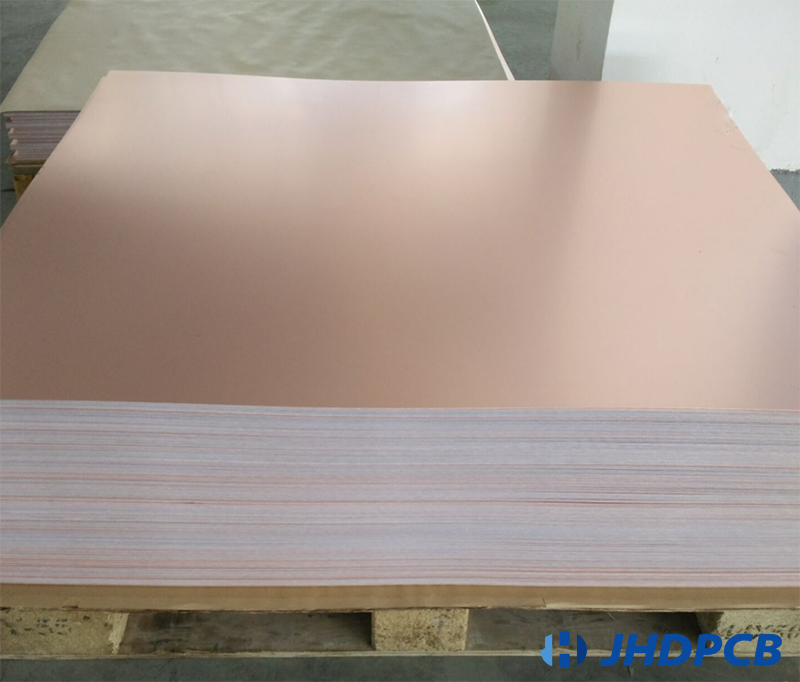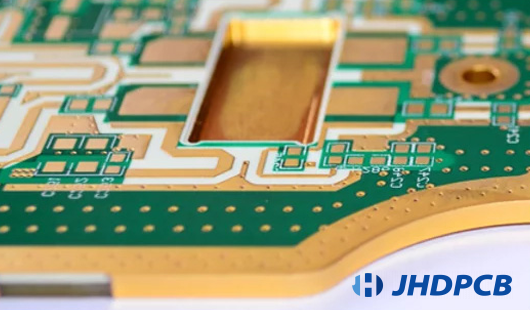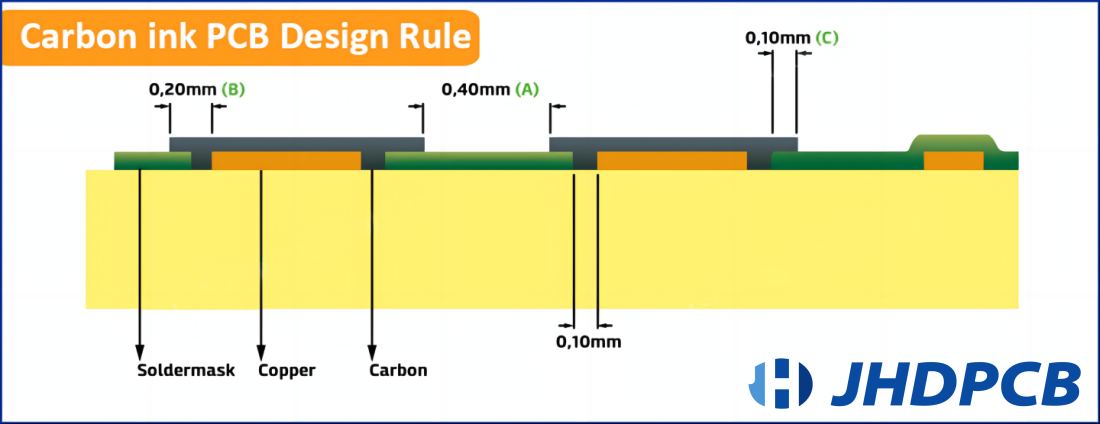What is CCL? and classification methods.
sales@jhdpcb.com
directory
What is Copper Clad Laminate (CCL)?
Copper clad laminate (CCL) is a kind of plate-like material which is made of resin impregnated electronic glass fiber cloth or other reinforcing materials, and copper foil covering one or both sides and hot pressing. It is called copper clad laminate. Printed circuit boards with different forms and functions are selectively processed, etched, drilled and plated on copper clad laminates to make different printed circuits. Copper clad laminate is a very important component of PCB laminate. It plays the role of interconnection, insulation and support in the overall circuit of the board, and plays a large role in signal transmission speed, energy loss and characteristic impedance. So, the performance, quality and manufacturing cost of PCB always affected by the processing performance, manufacturing level, manufacturing cost, long-term reliability and stability of CCL . Copper clad laminates are widely used in televisions, radios, computers, mobile communications, medical equipment and various electronic components.
What are the common classification methods of CCL?
Each PCB has unique requirements and specifications. Engineers in charge of project development will choose the best option based on usage conditions. Then according to different classification standards, Copper Clad Laminates can be divided into various categories:
- According to the mechanical rigidity of the laminates, it can be classified as Rigid Copper Clad Laminate (Rigid Copper Clad Laminate: FR-4, CEM-1, etc.) and Flexible Copper Clad Laminate (Polyimide).
- According to different insulating materials and structures, it can be classified as organic resin copper CCL (FR-4, CEM-3, etc.), metal core CCL, and ceramic-core CCL.
- According to the thickness of the laminates , it can be divided into thick plates (with a thickness of 0.8 to 3.2 mm (including Cu)) and thin plates (with a thickness of less than 0.78 mm (without Cu)).
- According to the reinforcement materials of the laminates, it is divided into glass fiber cloth base CCL (FR-4, FR-5), paper base CCL (XPC), composite base CCL (CME-1, CME-2) and phenolic CCL. Copper plate (FR-1, XPC).
- According to the different insulating resins used in the laminates, it can be divided into polyester resin CCL, epoxy resin CCL (FR-4, CEM-3), cyanate resin CCL.
- According to the flame retardant grade, the laminates are divided into flame retardant board and non-flame retardant board: According to UL standards (UL94, UL746E, etc.), the flame retardant grade of CCL is divided, and rigid CCL can be divided into four different flame retardant grades : Namely UL-94V0 grade; UL-94V1 grade; UL-94V2 grade and UL-94HB grade.
What are the factors for the quality judgment standard of CCL?
The quality of the CCL directly affects the quality of the finished PCB. The standard of the quality of CCL are as below:
Bending Strength: The bending strength indicates the ability of the copper clad plate to withstand bending, and the unit is kg/cm. . This indicator mainly depends on the substrate material of the copper clad plate. This indicator should be considered when determining the thickness of the printed board.
Electrical Properties: This is important key factor for qualified PCB, so must pay attention to any aspect that affects its electrical performance,such as dielectric constant, dielectric breakdown voltage, dielectric loss tangent, insulation resistance,volume resistance, comparative leakage index (CTI),Surface resistance,arc resistance, electric strength, and son on. This is especially important when circuit impedance control is required.
Physical Properties: The physical performance parameters including bending strength, dimensional stability, ,heat resistance stamping quality, peel strength etc. The peel strength is the minimum force required to peel the copper foil per unit width from the substrate, and the unit is kg/cm. Use this indicator to measure the bonding strength between the copper foil and the substrate. This index mainly depends on the performance and manufacturing process of the adhesive.
Appearance Surface Clean: Due to some unexpected factors in the manufacturing process, such as dents, scratches, resin spots, wrinkles, pinholes, air bubbles, etc., may cause problems with copper foil. All these issues will definitely lead to the degradation of the performance of the CCL and PCB. Therefore, the appearance of an excellent CCL should be flat and smooth.
Size: Since the CCL is the base material of the PCB, it must meet the size requirements of the target PCB. Parameters related to CCL dimensions include width, length, slanting stitch and warpage, each of which must be with specific requirements. In particular, warpage, which measures the unevenness of the copper-clad laminate relative to the plane, depends on the substrate material and thickness.
Chemical Properties: The chemical properties of CCL must meet strict requirements such as chemical resistance, flammability, Tg, Z-axis thermal expansion coefficient (Z-CTE), and dimensional stability.
Dip Soldering Resistance: Dip soldering resistance refers to the anti-stripping ability of copper foil that can be endured after the copper-clad plate is placed in molten solder at a certain temperature for a period of time (usually 10s). It is generally required that the copper foil board should not be blistered or delaminated. If the dip solderability is poor, the pads and wires may fall off when the printed board is soldered for many times. This index has a great influence on the quality of printed circuit boards, mainly depending on the board and adhesive.
Environmental Properties: Water absorption and corrosion resistance must be ensured to meet requirements. Or the production process may experience severe performance failures.

Copper Clad Laminate (CCL) raw Materials:
As the core material of PCB, the three main raw materials for the production of CCL include glass fiber cloth, epoxy resin and copper foil, and PCB relies on them to realize the functions of conduction, insulation and support. Among them, glass fiber cloth and epoxy resin are often used as prepregs.
Prepreg:
Prepreg is the reinforcing material inside the copper clad laminate, which is made of glass fiber after baking. The resin is pre-dried but not so hard that it will flow, stick and completely submerge when heated. Glass fiber reinforcement is then carried out through a bonding layer of prepreg (similar to FR4 material). Therefore, it is often called adhesive sheet, which is composed of epoxy resin, glass fiber cloth, DMF, 2MI, acetone, etc.
There are different requirements on the type of prepreg for different manufacturers. In addition, based on resin material, “SR” standard resin, “MR” medium resin, and “HR” high resin versions are the most suitable materials. This all depends on the desired final thickness, layer structure or impedance. Therefore, all The mentioned thicknesses are to be regarded as examples only.
| JHDPCB Partial Manufacturing Capability in Prepreg | |||
|---|---|---|---|
| Prepreg | Gel Time (s) | Resin Content | Thickness |
| 1080 | 135±15 | 62±1.5% | 3mil |
| 2112 (2113, 2313) | 135±15, 115±15 | 57±1.5%, 59.5%-62.0% | 4mil |
| 2116 | 135±15 | 49.5±1.0%, 53±1.5% | 5mil |
| 7268 | 113±15, 135±15 | 44±1.5%, 38±1.5%, 41±1.5% | 7mil |
The properties of glass fibers can be summarized in the following aspects:
- Moisture resistance;
- Heat and fire resistant;
- High strength;
- Excellent insulating ability
Types of resins:
- Epoxy resin;
- Phenolic resin;
- Polyimide resin;
- Polytetrafluoroethylene resin (PTFE or TEFLON resin)
- Bismaleimide triazine (BT)
In terms of prepreg cost, fiberglass cloth accounts for the majority of the cost. In general, the cost of prepreg is according to thickness of the fiberglass cloth.The thinner the prepreg, the higher the price. High-quality prepregs produce high-quality CCLs, which in turn affect PCBs. Therefore, JHDPCB attaches great importance to the testing and control of prepreg quality. From supplier selection to inventory management, we will strictly control to provide customers with high-quality PCBs. Check out JHD’s CCL database.
Copper Foil:
| Copper foil process and grade table: | |||
|---|---|---|---|
| Class | Type | Name | Code |
| 1 | E | Standard electrodeposited | STD-Type E |
| 2 | E | High ductility electrodeposited | HD-Type E |
| 3 | E | High temperature elongation electrodeposited | HTE Type E |
| 4 | F | Annealed electrodeposited | ANN-Type E |
| 5 | W | As rolled-Wrought | AR Type W |
| 6 | W | Light cold rolled-Wrought | LCR Type W |
| 7 | W | Anneal-Wrought | ANN Type W |
| 8 | W | As rolled-Wrought low-temperature annealable | ARLT Type W |
If you don’t know which material is right for your current PCB application. You can contact our engineers to send your Gerber files, and we will provide the best selection suggestions based on your application conditions, PCB design and production process requirements while conducting a free PCB file inspection. This paper makes a comprehensive study of CCL, including its types and quality criteria. Pls remember to visit our blog if you want to get more about PCB boards, and other PCB production knowledge about the PCB industry. JHDPCB is definitely an experienced and responsible PCB manufacturer.









